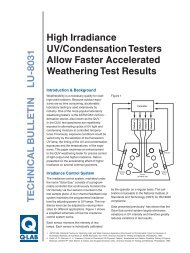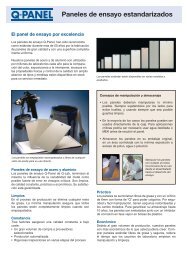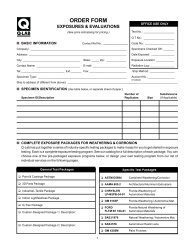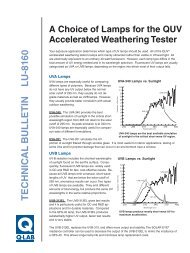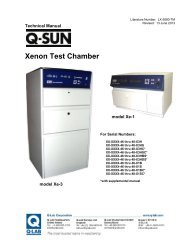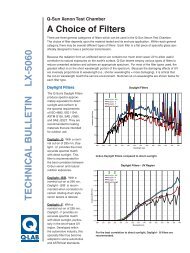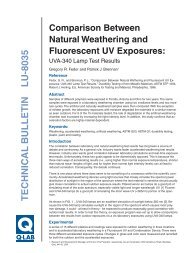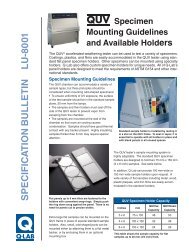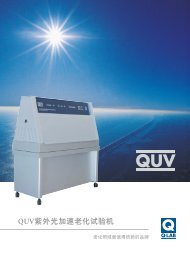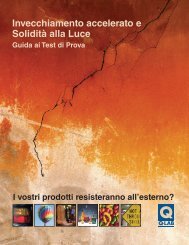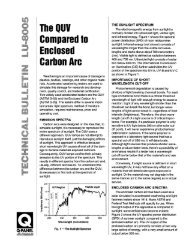Sunlight, Weathering, Light Stability - Q-Lab
Sunlight, Weathering, Light Stability - Q-Lab
Sunlight, Weathering, Light Stability - Q-Lab
Create successful ePaper yourself
Turn your PDF publications into a flip-book with our unique Google optimized e-Paper software.
12<br />
1.2<br />
1.0<br />
<strong>Sunlight</strong><br />
10<br />
Q-Trac<br />
Irradiance (W/m 2 /nm)<br />
0.8<br />
0.6<br />
0.4<br />
FS-40<br />
UVB-313<br />
Irradiance (W/m 2 /nm)<br />
8<br />
6<br />
4<br />
<strong>Sunlight</strong><br />
2<br />
0.2<br />
0.0<br />
250 270 290 310 330 350 370 390<br />
Wavelength (nm)<br />
Figure 10- UVB-313 and FS-40<br />
0<br />
250 300 350 400 450 500 550 600 650 700<br />
Wavelength (nm)<br />
Figure 12- Q-TRAC Concentrator and <strong>Sunlight</strong><br />
UVA-340 Lamps were designed to enhance correlation<br />
with natural exposures. The UVA-340 has<br />
been extensively used for both plastics and coatings,<br />
and greatly improves the correlation possible<br />
with QUV testers. Figure 11 shows the UVA-340<br />
compared to the Solar Maximum. This lamp is an<br />
excellent simulation of sunlight from about 370 nm<br />
to the solar cut-off of 295 nm.<br />
Irradiance (W/m 2 /nm)<br />
1.2<br />
1.0<br />
0.8<br />
0.6<br />
0.4<br />
UVA-340<br />
<strong>Sunlight</strong><br />
Filtering Effect of<br />
Glass on <strong>Sunlight</strong><br />
Common Window Glass. Glass of any type<br />
acts as a filter on the sunlight spectrum. The<br />
shorter, more damaging wavelengths are the most<br />
greatly affected. Figure 13 shows direct sunlight<br />
compared to sunlight filtered though ordinary,<br />
single-strength, untinted, 0.125 inch thick window<br />
glass. Ordinary glass is essentially transparent to<br />
light above 370 nm. However, the filtering effect<br />
becomes more pronounced with decreasing wavelengths.<br />
In fact, the most damaging wavelengths<br />
below about 310 nm are completely filtered out.<br />
3.00<br />
6<br />
0.2<br />
0.0<br />
250 270 290 310 330 350 370 390<br />
Wavelength (nm)<br />
Figure 11- UVA-340 and <strong>Sunlight</strong><br />
Q-TRAC Natural <strong>Sunlight</strong> Concentrator.<br />
Accelerated outdoor weathering devices that use<br />
natural sunlight as their light source have been<br />
used for many decades. Simple, early versions<br />
were designed to follow the sun from morning until<br />
night in order to maximize the amount of sunlight<br />
that an outdoor exposure specimen could receive.<br />
Later, mirrors were added to concentrate the<br />
sunlight onto the test specimens for even greater<br />
acceleration. This solar concentrating acceleration<br />
technique has been standardized in ISO 877,<br />
ASTM G90 and SAE J1961, among others.<br />
The Q-TRAC and other sunlight concentrators<br />
use a series of 10 mirrors to reflect full spectrum<br />
sunlight. The spectrum that the test specimens<br />
actually receive is affected by the fact that the device<br />
utilizes only direct beam sunlight and that the<br />
reflectivity of the mirrors is not perfectly efficient.<br />
Figure 12 shows a comparison of natural sunlight<br />
and the Q-TRAC concentrator spectrum.<br />
Irradiance (W/m 2 /nm)<br />
2.50<br />
2.00<br />
1.50<br />
1.00<br />
0.50<br />
<strong>Sunlight</strong><br />
Through<br />
Window<br />
Glass<br />
0.00<br />
260 300 340 380 420 460 500 540 580 620 660 700 740 780<br />
Wavelength (nm)<br />
Figure 13- <strong>Sunlight</strong> Through Window Glass<br />
Automotive Glass. Automotive glass is thicker<br />
than window glass. It is frequently tinted and<br />
windshield glass normally contains a layer of laminated<br />
plastic. Figure 14 shows a comparison of<br />
direct sunlight with sunlight through window glass<br />
and sunlight through windshield glass. All of these<br />
act to improve the filtering efficiency of auto glass<br />
and almost all of the most damaging UV is filtered<br />
out. Figure 15 shows the SPD of four different<br />
types of automotive glass, with varying thickness<br />
and tint combinations.



